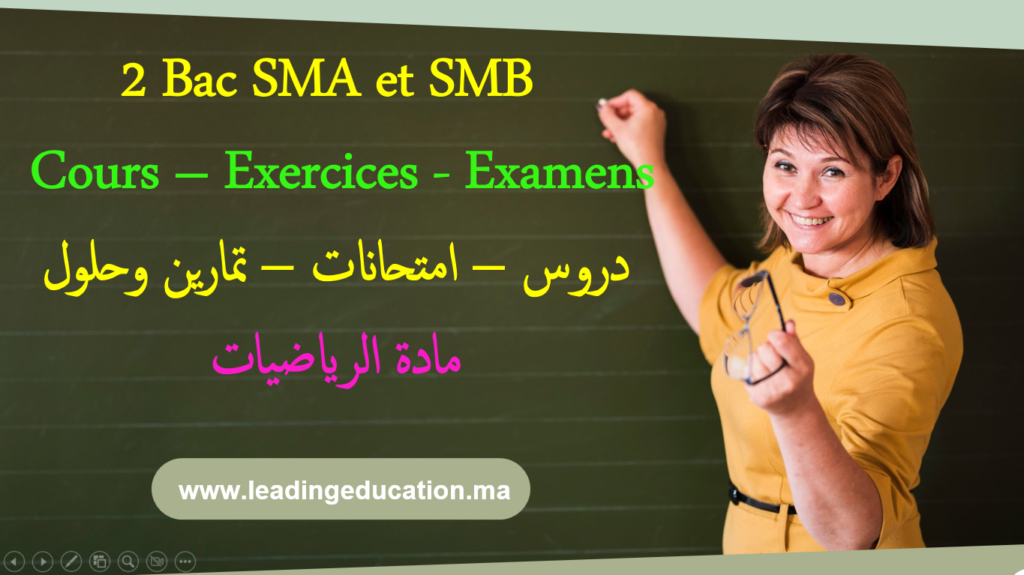Dérivation et Étude des Fonctions
2ème BAC Sciences Mathématiques
Exercice 1 : Dérivées usuelles
Calculer les dérivées :
- \( f(x) = 5x^4 – 3x^3 + 2x – 7 \)
- \( g(x) = \sqrt{3x + 2} \)
- \( h(x) = \frac{2x – 1}{x^2 + 1} \)
- \( f'(x) = 20x^3 – 9x^2 + 2 \)
- \( g'(x) = \frac{3}{2\sqrt{3x + 2}} \)
- \( h'(x) = \frac{2(x^2 + 1) – (2x – 1)(2x)}{(x^2 + 1)^2} = \frac{-2x^2 + 2x + 2}{(x^2 + 1)^2} \)
Exercice 2 : Tangente et position
Pour \( f(x) = x^3 – 3x^2 + 2 \) :
- Déterminer l’équation de la tangente en x=1
- Étudier la position relative courbe/tangente
- \( f'(x) = 3x^2 – 6x \) ⇒ \( f'(1) = -3 \), \( f(1) = 0 \)
Tangente : \( y = -3(x – 1) \) - \( f(x) – (-3x + 3) = x^3 – 3x^2 + 3x – 1 = (x – 1)^3 \)
Signe dépendant de x-1
Exercice 3 : Théorème de Rolle
Soit \( f(x) = x^3 – 4x \) sur [-2, 2] :
- Vérifier les hypothèses du théorème
- Trouver c ∈ ]-2, 2[ tel que f'(c) = 0
- f continue/dérivable (polynôme) et f(-2) = f(2) = 0
- \( f'(x) = 3x^2 – 4 \) ⇒ \( c = \pm \frac{2\sqrt{3}}{3} \)
Exercice 4 : TAF
Pour \( f(x) = \ln(x) \) sur [1, e] :
- Appliquer le TAF
- Trouver c vérifiant la conclusion
- f continue sur [1,e], dérivable sur ]1,e[
- \( \frac{f(e)-f(1)}{e-1} = \frac{1}{e-1} \), \( f'(c) = \frac{1}{c} \) ⇒ \( c = e – 1 \)
Exercice 5 : Variations
Pour \( f(x) = \frac{x^2 – 1}{x} \) :
- Déterminer Df
- Étudier les variations
- Df = ℝ*
- \( f'(x) = 1 + \frac{1}{x^2} > 0 \) ⇒ strictement croissante
Exercice 6 : Extremums
Pour \( f(x) = x^3 – 6x^2 + 9x \) :
- Calculer f'(x)
- Déterminer les extremums
- \( f'(x) = 3x^2 – 12x + 9 \)
- Maximum local en x=1 (f(1)=4), minimum local en x=3 (f(3)=0)
Exercice 7 : Dérivée logarithmique
Pour \( f(x) = x^x \) (x > 0) :
- Utiliser la dérivée logarithmique
- Calculer f'(x)
- \( \ln(f(x)) = x\ln(x) \) ⇒ \( \frac{f'(x)}{f(x)} = \ln(x) + 1 \)
- \( f'(x) = x^x (\ln(x) + 1) \)
Exercice 8 : Étude complète
Pour \( f(x) = \frac{x^2}{x – 1} \) :
- Domaine et limites
- Variations et extremums
- Df = ℝ\{1}, limx→1 = ±∞, limx→±∞ = ±∞
- \( f'(x) = \frac{x(x – 2)}{(x – 1)^2} \), minimum en x=2 (f(2)=4)
Exercice 9 : Exponentielle
Pour \( f(x) = e^{-x^2} \) :
- Calculer f'(x)
- Étudier la convexité
- \( f'(x) = -2x e^{-x^2} \)
- \( f”(x) = (4x^2 – 2)e^{-x^2} \), convexe sur ]-∞, -1/√2[ ∪ ]1/√2, +∞[
Exercice 10 : Optimisation
Un rectangle a un périmètre de 20 cm :
- Exprimer l’aire A en fonction d’un côté x
- Trouver les dimensions pour A maximale
- \( A(x) = x(10 – x) = 10x – x^2 \)
- \( A'(x) = 10 – 2x \), maximum en x=5 ⇒ carré 5×5 cm




Pingback: مادة الرياضيات شعبة العلوم الرياضية ـ أ ـ السنة الثانية بكالوريا 2Bac SMA – موقع التعليم الرائد